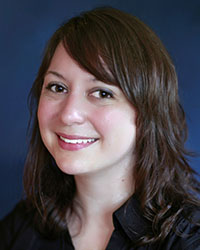2014 Janet Taylor Spence Award

Leah H. Somerville
Harvard University
What is the focus of your award-winning research?
My lab’s research focuses on understanding the neurodevelopmental contributions to adolescents’ motivated, emotional, and social behavior. Adolescence is a phase of the lifespan in which affective–motivational, social, and regulatory processes are dynamically changing in ways that impact thoughts, choices, and emotional experiences. We believe that dynamic trajectories of brain development, which are thought to influence brain function in complex ways, play a key role in shaping the interplay between these processes and ultimately make adolescents unique compared to both children and adults.
Whereas trajectories of brain development confer remarkable benefits to adolescents’ well-being and abilities, we believe these trajectories also contribute to certain risks that threaten adolescents’ health. Our work combines multiple approaches (behavioral; psychophysiological; structural, functional, and connectivity brain imaging) to triangulate the relationships between neurodevelopment, adolescent behavior, and adolescents’ experiences in motivational, emotional, and social domains that might shed light on emerging risk for psychopathology and other negative health outcomes.
A long-term goal is to address the broader issue of how brain function dynamically supports variability in emotional and motivated behavior across people, over short and long timescales, and in diverse contexts.
How did you develop an interest in this area?
In my lab, we often joke that “research is me-search,” and I suppose I am a perfect example. I was an “angsty” teenager who experienced firsthand the confusions and emotional variability that many adolescents do. I continued to follow my interest in adolescent health risks during college, spending 4 years volunteering as a teen crisis counselor; I planned to go into social work. Late in college, I became exposed to the strong affective neuroscience community at the University of Wisconsin, and I became heavily involved with laboratory research in the area. I then continued to study cognitive and affective neuroscience through graduate school. It wasn’t until my postdoc that I began to apply empirical approaches to my early fascination with adolescent-typical behaviors like reward sensitivity, emotional lability, and sensitivity to peers. Seeing as one goal of my lab’s research is to reveal biological mechanisms of adolescents’ shifting experiences in these domains, I suppose I’ve come full circle.
Who are your mentors and/or biggest psychological influences?
I would like to dedicate this award to my mentors. My postdoctoral mentor BJ Casey took a real chance on bringing me into her lab in spite of the fact that I had no experience doing developmental research. I credit her for dedicating so much support and energy to my training, and for providing me solid foundations in developmental cognitive neuroscience.
I benefited from the joint mentorship of Bill Kelley (primary mentor) and Todd Heatherton and Paul Whalen (secondary mentors) during my graduate studies at Dartmouth College. Through Bill I was exposed to rigorous brain-imaging methodology, and my research on sustained emotion was strongly influenced by his expertise in the role of the prefrontal cortex in task-set maintenance. Todd encouraged me to view my interests through a social-contextual lens and regularly provides career guidance. Paul has influenced my thinking about emotion through a learning and vigilance framework, and instilled in me the value of translational research. I credit all of my graduate mentors for encouraging my independence. I also thank mentors from Wisconsin, Ned Kalin and Tom Johnstone, for emphasizing the utility (dare I say necessity) of considering individual differences when studying emotional processes.
Currently, my strongest influences are my colleagues at Harvard and in the greater Boston area, especially Mahzarin Banaji, Lisa Feldman Barrett, Joshua Buckholtz, Randy Buckner, Avram Holmes, Jill Hooley, Jerome Kagan, Ellen Langer, Jason Mitchell, Joe Moran, Charles Nelson, Matthew Nock, Margaret Sheridan, Nao Uchida, and John Weisz. Interacting with them challenges me to examine my own work from diverse perspectives.
What unique factors have contributed to your early success?
I would not be able to do this work without the members of my lab, who teach me every day. Their intellect and dedication is inspiring, and their enthusiasm for science is contagious. Channeling their energy and ideas (and providing the coffee) is the only thing I can really take credit for.
Beyond that, my work cannot be categorized into a single domain of psychology. My research has been described every which way, from social to clinical to developmental. I used to see the uncategorizable nature of my work as a weakness, worrying that by stretching everywhere, I fit nowhere. However, it seems that a new wave of psychological scientists sit in the center of many areas the way I do, and whatever successes we’ve had speaks to the value of interdisciplinary research.
What does winning this award mean to you both personally and professionally?
I am humbled by this honor, especially because it is named after Janet Taylor Spence, a tenacious scientist and role model. Most of all, I appreciate having a platform to acknowledge all the remarkable people who shape my thinking and make science fun.

